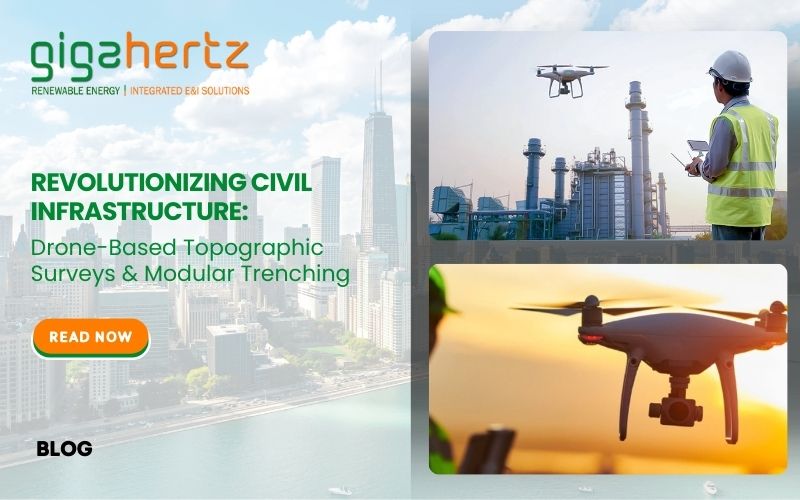
In
today’s fast-evolving infrastructure landscape, the integration of advanced
surveying and construction technologies is no longer a luxury—it’s a
necessity. Two such innovations, drone-based topographic surveys and modular
trenching, are rapidly transforming how civil works are planned, executed,
and maintained in sectors like power transmission, renewable energy, substations,
and smart cities.
Drone-Based Topographic Surveys: Eyes in the Sky
What Are They?
Drone
(UAV)-based surveys utilize high-resolution aerial imaging and geospatial
technology to map terrain features, contours, and land-use with
unprecedented speed and accuracy.
Key Deliverables:
- Digital
Elevation Models (DEMs)
- Digital
Terrain Models (DTMs)
- Orthomosaic
Maps
- 3D
Point Clouds
- Contour
and Volume Analysis
Why Drones Over Traditional Survey?
|
Traditional Survey |
Drone-Based Survey |
|
Manual,
labor-heavy |
Automated,
minimal manpower |
|
Time-consuming
(days to weeks) |
Rapid
(hours for 100+ acres) |
|
Prone
to human error |
High
accuracy with RTK-GPS |
|
Inaccessible
terrain is difficult |
Easily
covers forests, hills, and waterlogged areas |
Applications:
- Route
alignment for transmission lines
- Civil
grading for solar and wind farms
- Earthwork
planning in substations
- Hydrology
and drainage flow mapping
- Environmental
monitoring and compliance
Modular
Trenching: Speed Meets Precision
What Is Modular Trenching?
Modular
trenching involves the use of precast or prefabricated trench systems,
as well as mechanical trenching equipment like micro-trenchers and chain
trenchers, to simplify underground utility installations.
Types:
- Precast
RCC Trenches – Ideal for control and power cables in
substations.
- FRP/Polymer
Trenches – Lightweight and corrosion-resistant.
- Mechanical
Trenching – Ideal for long runs like solar PV cables or
telecom OFC.
Benefits:
- Speed:
40–60% faster than traditional in-situ RCC trenches.
- Clean
Execution: No debris, minimal curing time.
- Uniformity:
Factory-made modules ensure consistent quality.
- Integration:
Allows for embedding of earthing, drainage, and cable trays.
- Safety
& Longevity: Better load bearing and ingress protection.
Applications:
- Substation
cable trenches (LV, HV, control, SCADA)
- Solar/wind
farm cable routing
- Smart
city utility channels (OFC, gas, water)
- Industrial
and commercial power corridors
The Power of Integration
Imagine
this scenario:
“A 220 kV
substation site is scanned using drones in a day. Contour models are generated
and civil earthwork is optimized. Precast modular trenches are laid out as per
the drone model, reducing the trenching time from 30 days to 10.”
This is not the future. This is happening today—and is a major cost and time saver for EPCs, DISCOMs, and renewable developers.
Smart Civil
for Smart Energy
When used
together, drone surveys and modular trenching offer:
- End-to-end
digitization of civil works
- GIS
& BIM-ready data
- Real-time
monitoring and reporting
- Reduced
rework and downtime
- Improved
safety and compliance
Conclusion
Adopting
drone-based topographic surveys and modular trenching is not just a matter of
modernizing civil infrastructure—it's about enabling precision, reducing
costs, and delivering projects faster.
For power
sector developers, renewable energy companies, and urban infrastructure
planners, these innovations represent a strategic advantage in a
competitive landscape.
Category: Drone-Based survey
